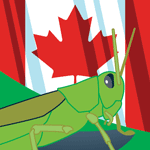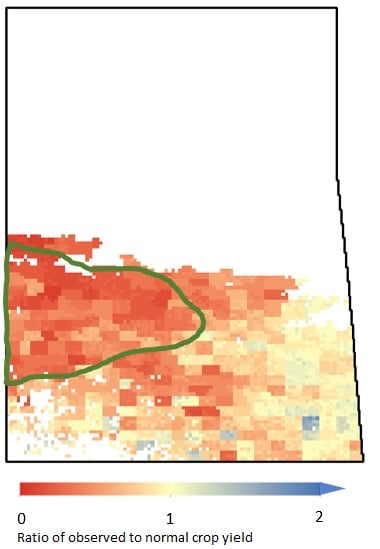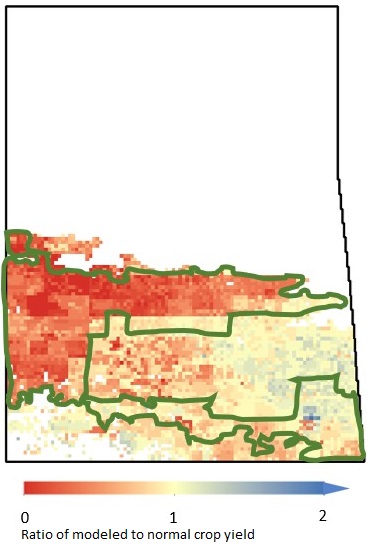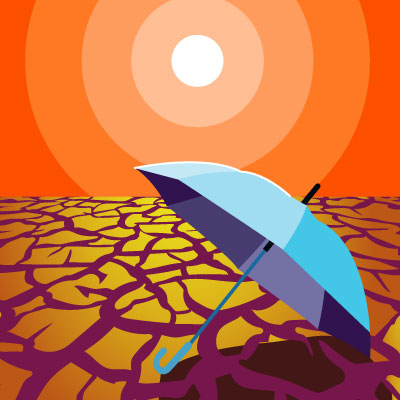
Crops in Canada face many weather hazards, including drought, flood, freezing temperatures, and hail. The Prairie Provinces—Manitoba, Saskatchewan, and Alberta—also feature a different kind of hazard: grasshoppers. A single grasshopper can eat a square foot of crop in a season, and they enjoy the cereal grains that dominate the cropland.
There are more than 80 species of grasshoppers in the Canadian Prairies, but only a few are pest species—and some of those will attack only certain crops. The following are not pests:
- Grasshoppers flying before June
- Grasshoppers with hind wings highly visible in flight (i.e., red, yellow, orange or black)
- Grasshoppers that sing, call, clack, clatter, or make other similar sounds, either in flight or on the ground
A common method of rating fields for grasshopper risk is to estimate “foot-square” counts. These are done by walking in a field to disturb the grasshopper nymphs (immature grasshoppers with no wings or small wings) and counting how many jump from an area of one square foot. A sample average of one or more grasshoppers per square foot could be a risk to crops, while lower numbers could damage seedlings or flowering crops.
Both chemical and cultural control practices can be used for grasshoppers. Chemical control includes insecticides and poisoned bait—such as trap strips to attract grasshoppers to small areas that can then be chemically treated—whereas cultural control methods include:
- Crop and cultivar selection for grasshopper-resistant strains
- Early seeding so that plants are larger and can withstand more grasshopper damage in summer
- Weed control to discourage egg-laying in the fall and remove potential food sources for young grasshoppers
Grasshopper populations are highly dependent on weather conditions. The largest population booms are associated with several preceding years of hot, dry summers —which can reduce the population of birds and rodents that prey on them—and warm autumns, which allow mature grasshoppers more time to feed and to lay eggs. Cool, wet summer weather, on the other hand, hinders grasshopper development and increases the possibility of grasshopper diseases.
One of Canada’s costliest natural disasters was the significant drought in 2001 that extended coast to coast. The dryness was so intense that the government of Alberta declared a drought even before the first day of summer. Wheat and canola production plunged 43% from the previous year, net farm income in Alberta was zero, more than 40,000 jobs were lost across Canada, and economic costs were estimated to be CAD 5.8 billion.
A dry fall in 2001 allowed lots of grasshopper eggs to be laid, and a mild winter allowed them to survive until the spring of 2002, which brought no relief to Alberta and Saskatchewan, where dry soil conditions and above-normal temperatures continued through the growing season. The heat of June and July 2002 benefited the development of grasshoppers; western Saskatchewan was particularly hard hit by grasshoppers. The infestation in the southwest of the province was not as bad as predicted due to heavy spring rains that slowed insect development , but areas north of the South Saskatchewan River did not receive rain and had an infestation that was worse than predicted.
Hardest-hit areas were in the west-central part of the province. Some fields were damaged so badly by drought and grasshoppers that farmers cut their losses (e.g., use of more fertilizer, harvesting costs) and filed for pre-harvest insurance claims. In 2002, output of western Canada's six major crops was down 25% from 2001. Figure 1 is a map of the observed canola yields relative to normal in Saskatchewan in 2002 with areas frequently cited as heavily impacted by grasshoppers circled.

The AIR MPCI Model for Canada determines the effect of grasshopper infestations on crop yields by tracking weather on an 8-km grid across Canada. Temperature and soil moisture levels are assessed beginning in the fall before each crop year through the summer of the crop year in question to look for the sequence of weather conditions (i.e., dry fall, warmer-than-normal winter, cooler-than-normal spring, and warmer-than-normal summer) that precedes a grasshopper infestation. Crop yields that have been affected by dryness and heat during the growing period are significantly lowered by severe infestations.
The effect of a grasshopper infestation differs by location—based on climate, crop mix, and grasshopper mitigation measures used. For that reason, historical observed yields and weather are used to develop the criteria for detecting grasshopper infestations. Figure 2 is a map of the AIR modeled canola yields relative to normal for Saskatchewan in 2002. The areas impacted by grasshoppers in the AIR model are outlined. It should be noted that in 2002 grasshopper infestation was not tracked systematically; the reported impact represented in Figure 1 is an anecdotal assessment, and compared with the AIR model it is probably weighted to the most severe areas.

Grasshoppers represent a localized risk for crops in Canada that have the potential to cause significant losses. The AIR MPCI Model for Canada—the country’s first MPCI model—is anticipated for release in 2018. As an advanced risk management tool that accounts for both generalized large-scale and local risks, it can help companies better understand their risk and make more informed decisions.
To learn more, read our blog “The Complicated Problem of Modeling Crop Risk in Canada”



